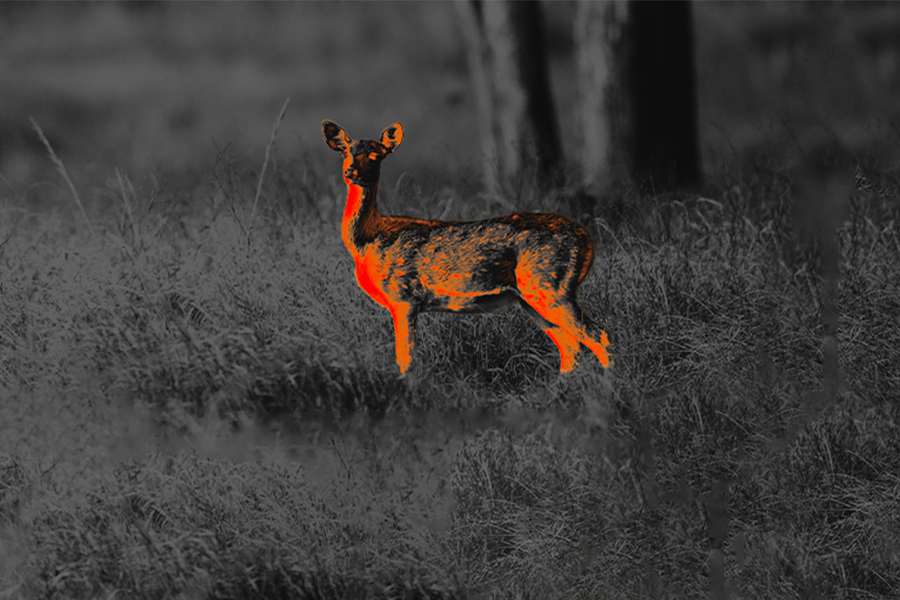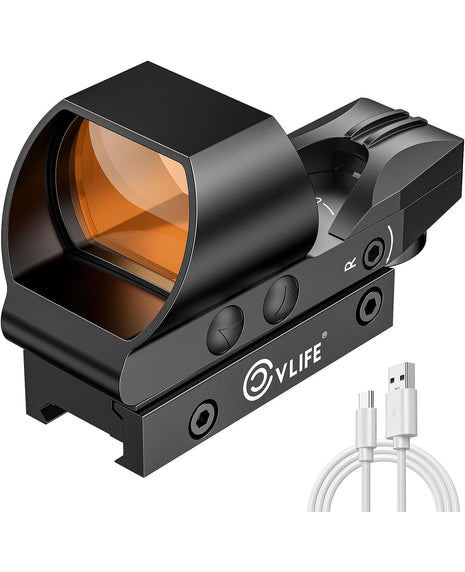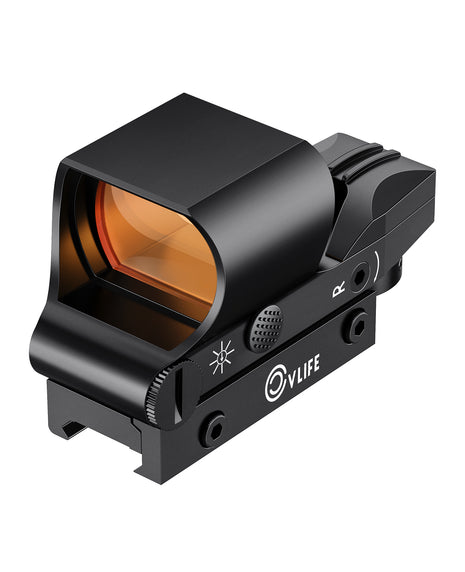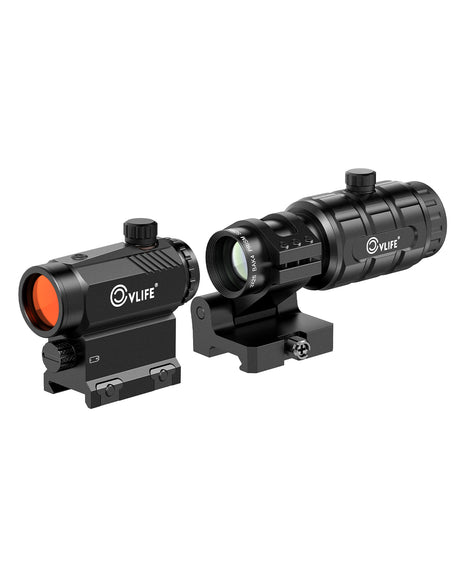Most Shooters Get This Wrong: The Correct AR-15 Sighting Distance
- 10 Tiempo mínimo de lectura

If you've asked yourself “Should I zero my AR at 100 yards?” — you're not alone. Shooters, instructors, and armory techs debate 25, 36, 50 and 100-yard zeros constantly. The right answer depends on your optics, typical engagement distances, and whether you value speed or precision. This guide walks through the pros and cons of common zero choices, practical zeroing steps, mistakes to avoid, and how to use CVLIFE bore-sighting tools to make the process faster and more reliable. 🎯
What “zero distance” actually means for your AR-15
“Zeroing” a rifle means aligning your sights so that where the optic points (point of aim, POA) and where the bullet hits (point of impact, POI) coincide at a chosen distance. Because a bullet travels in an arc, one single zero can produce useful POI across a range of distances — but the exact pattern depends on bullet weight, muzzle velocity, and your sight height above bore. Instead of guessing, most shooters pick a zero that best matches their expected use: close-quarters, general-purpose, or long-range precision.
Important factors: ammunition type (e.g., 55gr vs 77gr), barrel length, and sight height. Ballistics calculators (Hornady, Federal, etc.) are excellent tools to plug in your load and see trajectory at different zeros. Use these to model how a 50-yard versus 100-yard zero will behave with your ammo.
Common zero distances — quick pros & cons
| Zero Distance | Best Use | Pros | Cons |
|---|---|---|---|
| 25 yards | Emergency / fast military quick-zero | Quick to get “on paper” for basic alignment | Can be high at 100 yards with many loads; less intuitive for civilians |
| 36 yards (≈33 m) | Pre-zero for a 300-yard battlesight zero (military origin) | Used historically for pre-zeroing before confirming at 100/300 yards | Often misunderstood — it's a procedural pre-zero, not the final long-range zero. |
| 50 yards | General-purpose / home defense / red dot users | Balanced true-for-purpose zero for 0–200 yard practical engagements | Not the longest-range precision zero, but excellent all-round |
| 100 yards | Precision shooters, hunters, magnified optics | Gives a simple reference point for holdovers and is intuitive with scopes | Requires more range space and slightly slower confirmation procedure |
Should I zero my AR at 100 yards?
Short answer: Maybe — it depends on your role and gear. If you primarily use a magnified optic (1-6x LPVO or higher) and plan to take shots at extended distances or hunt, a 100-yard zero is a logical, intuitive choice because the math and holdover points are easier to manage at longer ranges. If you mostly run a red dot or expect to engage inside 0–75 yards, a 50-yard zero often gives faster, more practical hits for defensive scenarios.
Why this varies: bullet trajectory and "where it crosses the line of sight" depend on ammo, barrel length, and sight height over bore. There is no single “one size fits all” number without modeling your specific load. Use a reputable ballistics calculator to see how your chosen ammo behaves at 50 vs 100 yards before committing.
Practical rule-of-thumb: if your engagements are mostly under 200 yards and you prefer fast, instinctive shots — consider a 50-yard zero. If you want a simple, scope-friendly zero for measured range work or hunting beyond 200 yards — 100 yards is a perfectly valid choice.
When a 100-yard zero makes sense
- Magnified optics: Scopes and LPVOs (with magnification) are designed with longer-range holds in mind, so a 100-yard zero is simpler to apply.
- Hunting & precision: When you want repeatable, verifiable groups at 100y as your baseline for ballistic charts.
- Dope & holdovers: Some shooters prefer a 100-yard zero because ballistic holdovers and drop tables are easier to read and scale from that baseline.
Remember: the USMC and other services use short pre-zero distances (like ~36 yards) as part of a pre-zero procedure, but those processes are steps toward an operational zero (e.g., 300 yards for the Marine Corps doctrine) — so read doctrinal material carefully if you're trying to match a service standard.
When not to choose 100 yards
If you run a reflex/red dot sight and most of your shots are inside 100 yards (home defense, close-range competition), a 100-yard zero can be less useful — it may add unnecessary steps to your training and hold calculations. For CQB and quick target acquisition, many trainers recommend a 50-yard zero as the best compromise.
Zero faster with CVLIFE bore-sighting tools (recommended)
If you want to speed up the zeroing process and reduce wasted rounds on paper, boresighters and laser bore sight kits are indispensable. On CVLIFE we have tools designed to get you on paper quickly so you can refine your zero with live fire. Below are two CVLIFE tools you can link directly to from your zeroing workflow:


While a bore-sighter gets you close, only live-fire groups confirm true impact for your load and barrel configuration.
Step-by-step: how to zero your AR properly (practical workflow)
1) Prepare
Ensure a safe range, backstop, and follow all range rules. Use consistent ammo — the same brand/weight you’ll typically use in the field. A stable rest or sandbags improves repeatability.
2) Bore-sight to save ammo (optional but recommended)
Use Bore Sight to get your optic on paper quickly. Insert the appropriate adapter, center the laser on the target, then adjust windage/elevation turrets until the reticle coincides with the laser dot. This step reduces the number of rounds needed for final zero.
3) Confirm live fire at your chosen zero distance
Fire 3-round groups at your chosen zero distance (50 yards or 100 yards) from a stable rest. Adjust turrets based on group location, then re-fire to confirm. Repeat until the POI matches the POA consistently.
4) Final checks & dope logging
Record your zero, ammo, environmental conditions, and any DOPE (data on previous engagements). If you used a 100-yard zero, record drop values for common distances you expect to shoot.
Common zeroing mistakes & how to avoid them
- Not using consistent ammo: Changing bullets changes trajectory — zero with the ammo you plan to use.
- Skipping bore sight steps: Shooting blind wastes rounds. Use a boresighter to cut range time.
- Poor rest or inconsistent holds: Use a stable rest and same technique for each group.
- Forgetting height-over-bore: Understand the optic height over bore; it affects short-range POI inside ~25 yards.
Practical recommendation — which zero to pick in 2025
For most civilian shooters running a red-dot or quick LPVO on a carbine: 50 yards is an extremely practical, versatile zero. For dedicated precision work and hunting where you’ll frequently make measured shots past 200 yards, 100 yards (or confirming zero at 100 yards) remains a solid, intuitive choice.
Thanksgiving Special — Save 30% on CVLIFE gear 🎉
Use code GE30 at checkout. Offer ends Nov 27. Perfect time to grab a bore-sighting kit or red dot for range season.
Frequently Asked Questions (Click to reveal answers)
1. Should I zero my AR-15 at 100 yards?
It depends on what you do with the rifle. If you run magnified optics and plan measured shots beyond 200 yards, a 100-yard zero is logical and intuitive. If you run a red dot or expect most shots inside 100 yards, a 50-yard zero is often better for quick, practical hits. Always confirm with live fire.
2. Can a bore-sighter replace live firing?
No — bore-sighters (like the CVLIFE Laser Bore Sight Kit or .223 boresighter) help get you on paper and save ammo, but they do not replace live-fire confirmation. Always verify and fine-tune your zero with real rounds at the range.
3. Does ammo choice change my zero?
Yes. Bullet weight, velocity and ballistic coefficient all affect trajectory. Use consistent ammunition when zeroing and log your DOPE for that specific load.
4. How many rounds should I expect to confirm a zero?
With a bore-sighter you can cut the number of confirmation rounds significantly. Without boresighting, plan on multiple 3-shot groups and adjustments — expect to fire enough groups to verify repeatability (often 9–15 rounds or more, depending on how close the first groups are). The key is consistency, not speed.
Tags
- Compartir en:
- Deel
- Tweet
- Póngale un alfiler.
- Messenger
- Correo electrónico
Featured collection
Blog posts
-

, por C V Most Shooters Get This Wrong: The Correct AR-15 Sighting Distance
-

, por C V How to Choose the Right Optic for Your New Rifle in 2025 🔍
-

, por C V What kind of scope 🔭 is best for an AR-15?
-

, por C V Night Vision & Thermal Scopes: Hunting’s New Frontier












